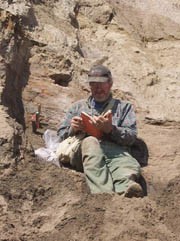John Westgate

Acceptance speech for the 2011 W.A. Johnston Medal
How does a glacial geologist get converted to a tephrochronologist? Well, it all began here in Quebec City 51 years ago, when I first stepped foot on Canadian soil. Freshly minted from Reading University, I was making my way to the University of Alberta to study for a Ph.D. degree in glacial geology, the topic later defined as the “Surficial Geology of the Foremost-Cypress Hills area, Alberta, Canadaâ€. During the course of fieldwork in the early 1960s I discovered several occurrences of silicic, distal tephra beds intercalated with late Quaternary sediments. Ray Wilcox of the USGS at Denver had just published a paper in Science on late Quaternary tephra beds in the Pacific Northwest, so I wrote to him with the request that he examine my tephra samples knowing that an identity might well throw light on the age of the host sediments in SE Alberta. He replied that he was too busy to meet my request but encouraged me to start a research project on this topic with the invitation that I could visit his lab at Denver where he would show me the petrographic techniques he used in his studies of volcanic ash. I accepted the challenge and once this became known, I started to receive numerous tephra samples across western Canada from field scientists. By the late 1960s I was able to put together a basic framework on the late Quaternary tephrochronology of western Canada. At the beginning of my first sabbatical in 1973 (I was then a faculty member of the Geology Department at the University of Alberta) my family and I went to Denver and stayed there all that summer. I worked with Ray Wilcox, and, importantly, Chuck Naeser, who at that time was a world-leader in fission-track dating. Recognizing the fission-track dating method as especially appropriate for distal tephra because of its grain-specific capabilities, I spent much time with Chuck learning the science and art of fission-track dating. The remainder of my sabbatical was spent in New Zealand where I worked with Colin Vucetich (Victoria University of Wellington) on proximal tephra beds in North Island. By this time I was well on the way to becoming a tephro-chronologist.
In 1975 I moved to the University of Toronto, and, amongst other duties, I became part of Bill Irving’s research group supporting his archaeological studies on the Old Crow Basin in the Yukon Territory. During the course of fieldwork, in particular, whilst teasing out the Quaternary stratigraphy of the Porcupine and Old Crow river bluffs, I again encountered thin silicic tephra beds, including one that later became known as “Old Crow tephra†– today, the best known tephra bed in Yukon and Alaska because of its strategic position immediately below the last interglacial deposits. Much of my subsequent tephra studies have been on the late Cenozoic tephrochronology of eastern Beringia. Highlights include work with Charlie Schweger (University of Alberta) and John Matthews (Geological Survey of Canada) on middle and early Pleistocene sediments along the Old Crow River in the mid 1980s, detailed tephrochronological work on the loess record of the Fairbanks area, Alaska, in the 1980s with Troy Péwé (Arizona State University), and later, during the 1990s to the present, work with Duane Froese (University of Alberta) in the Klondike goldfields.
So what is “tephrochronology� Simply put, the stratigraphic application of tephra – the dating and correlation of strata by tephra. Its roots go back to the late 1920s and are embedded in the disciplines of palynology (Iceland, South America) and soil science (New Zealand and Japan). Tephra recognition at that time was mostly by visual features discernible in the field and petrographic characteristics. Today, tephrochronology, properly practiced, involves an array of sub-disciplines within the Earth Sciences – e.g. stratigraphy, sedimentology, mineralogy, geochemistry, volcanology, geochronology, paleomagnetism and others. For this reason, publications are typically multi-authored, no one person being an expert in all of these fields. I’ve had the pleasure of working with many scientists on tephra projects – too numerous to mention individually here. The high quality of their contributions is one reason why I stand before you today. However, it would be remiss of me not to mention Shari Preece. We have worked together for over 25 years and I have benefited from her excellent grounding in igneous petrology and geochemistry. She is my most severe critic, and I consider that to be a positive thing.
It is well known that tephra beds are useful stratigraphic markers, each delineating a precise moment in time in the sedimentary record. Furthermore, their significance in piecing together fragmentary sedimentary records of geologic history is also well appreciated. In addition, the significance of a given tephra bed is greatly enhanced if its paleoenviromental context has been defined. Tephra beds then become both stratigraphic and paleoenvironmental markers. In the Yukon, others have elucidated the paleoenvironmental context of the numerous tephra beds I’ve described and in so doing have generated a greater awareness of their value. Persons who have made important contributions in this respect are John Matthews, Charlie Schweger, Grant Zazula, Duane Froese, Dick Harington, Dick Morlan, John Storer, Alice Telka, and others. The high quality of their contributions is another reason why I stand before you today.
I owe an enormous debt of gratitude to my wife Cora. She has supported me in all my endeavours – in and out of the field. The truth is that she has been the foundation stone upon which my career has been built and on which our family has grown.
Lastly, I wish to thank CANQUA and its executive for awarding me the W.A. Johnston Medal. It is a great source of satisfaction to know that my work has been of use to others. You have placed me in a group of scientists who have made huge contributions to the Quaternary Science of Canada – an honour and yet a humbling experience. Thank you!
John Westgate
Department of Geology
University of Toronto
